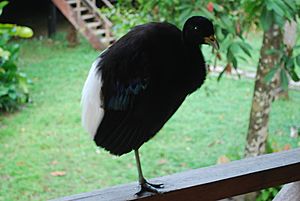Pale-winged trumpeter facts for kids
Quick facts for kids Pale-winged trumpeter |
|
|---|---|
 |
|
| near Puerto Maldonado, Peru | |
| Conservation status | |
| Scientific classification | |
| Genus: |
Psophia
|
| Species: |
leucoptera
|
 |
|
The pale-winged trumpeter (Psophia leucoptera) is a special type of bird. It's also called the white-winged trumpeter. This bird lives in the western Amazon rainforest in countries like Bolivia, Brazil, and Peru. It's currently listed as a Near Threatened animal, which means it could be in danger in the future.
Contents
What Kind of Bird Is It?
Scientists group animals together to understand them better. Most scientists agree that the pale-winged trumpeter is a unique species. This means it's monotypic, or the only one of its kind in its group. However, some people think another bird, the "ochre-winged" trumpeter, might be a type of pale-winged trumpeter. Other scientists believe the "ochre-winged" trumpeter is either a part of the grey-winged trumpeter family or its own separate species.
What Does the Pale-Winged Trumpeter Look Like?
The pale-winged trumpeter is a bit like a chicken, but with a longer neck and legs. It has a rounded back, making it look a little hunched. These birds are about 45 to 52 centimeters (18 to 20 inches) long.
Size and Appearance
Male trumpeters usually weigh between 1.28 to 1.44 kilograms (2.8 to 3.2 pounds). Females are a bit lighter, weighing 1.18 to 1.32 kilograms (2.6 to 2.9 pounds). Both males and females look very similar. Their strong, slightly curved beak is grayish with a yellow base. Their legs and feet are a light grayish color.
Feather Colors
Most of their body is black. But they have a bright white area on their back wings. The feathers on the outer part of their wings shimmer with purple, green, and bronze colors.
Where Do Pale-Winged Trumpeters Live?
You can find the pale-winged trumpeter in the upper Amazon Basin. This area includes eastern Peru, northern and central Bolivia, and central-western Brazil. They live south of the Amazon River and west of the Rio Madeira. There was one sighting in southeastern Colombia, but scientists haven't officially confirmed it.
Preferred Habitat
These birds love to live in thick, lowland tropical rainforests. They prefer areas far away from human homes. You can find them living at elevations up to about 750 meters (2,460 feet) high.
How Do Pale-Winged Trumpeters Behave?
Movement and Territory
Pale-winged trumpeters do not migrate, meaning they don't travel long distances. They tend to stay within the area where their group lives.
What Do They Eat?
These birds mostly eat fruit. They search the forest floor for ripe fruit that has fallen from trees. About 90% of their diet is fruit. The rest of their diet includes small animals like beetles and ants. Sometimes, they even eat small snakes.
Reproduction and Life Cycle
Pale-winged trumpeters live in groups and work together to raise their young. In each group, there is a main male and female pair. Only this main pair lays eggs. Other males in the group might mate with the main female, but only when she is not ready to lay eggs. When she is fertile, the main male will stop other males from mating with her.
Breeding Season
Their breeding season starts at the end of the dry season and continues through the rainy season. This usually happens between September and April. The female lays her eggs in a shallow hole in a tree. This nest is typically about 11 meters (36 feet) off the ground. They choose spots without vines or plants nearby to keep the eggs safe from predators.
Eggs and Chicks
A female usually lays three eggs, but sometimes it can be two to four. The eggs hatch after 23 to 29 days. The main male and female take turns sitting on the eggs to keep them warm. Other males in the group also help with this job. When the chicks hatch, they are covered in thick, dark, patterned feathers that help them blend in. The day after they hatch, the chicks jump down to the ground and follow the adult birds.
Cleaning Other Animals
Pale-winged trumpeters have a special relationship with animals like the gray brocket deer. This is called "cleaning symbiosis," where both animals help each other. The trumpeters follow the deer and peck at them to remove ticks. They also catch other pests like flies that are bothering the deer. This helps the trumpeters get food, and it helps the deer stay healthy by removing parasites.
Vocalization: What Sounds Do They Make?
All trumpeters are very noisy birds. The pale-winged trumpeter's song is a low "wuh-wuh-wuh wuh wuh - -". When they are alarmed, they make loud, harsh "KRETCH" sounds.
What Is Their Status?
The IUCN (International Union for Conservation of Nature) first said the pale-winged trumpeter was of "Least Concern." But since 2014, they have changed its status to "Near Threatened." This means the species could be at risk in the future.
Threats to Their Survival
The biggest danger to these birds is the fast rate of deforestation in the Amazon Basin. This means their forest homes are being cut down. Also, hunting is a serious threat to the species across the areas where they live.
Images for kids
See also
 In Spanish: Trompetero aliblanco para niños
In Spanish: Trompetero aliblanco para niños




